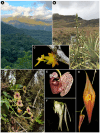Persistent Habitat Instability and Patchiness, Sexual Attraction, Founder Events, Drift and Selection: A Recipe for Rapid Diversification of Orchids
- PMID: 40284080
- PMCID: PMC12030281
- DOI: 10.3390/plants14081193
Persistent Habitat Instability and Patchiness, Sexual Attraction, Founder Events, Drift and Selection: A Recipe for Rapid Diversification of Orchids
Abstract
Orchidaceae is one of the most species-rich families of flowering plants, with most current diversity having evolved within the last 5 My. Patterns associated with species richness and rapid diversification have been identified but have not often been associated with evolutionary processes. We review the most frequently identified correlates of diversity and suggest that the processes and rate by which they occur vary geographically and are largely dependent on persistent pulses of habitat instabilities, especially for epiphytes. Aggressive orogenesis creates fragmented habitats while global climatic cycles exacerbate the ecological instabilities. The need for repeated cycles of dispersal results in frequent founder events, which sets the stage for allopatric diversification via bouts of genetic drift and natural selection. The allopatry requirement can be bypassed by pollination systems involving flowers attracting pollinators through the production of sex signaling semiochemicals. The drift-selection model of diversification, coupled with persistent habitat instability throughout ecological and geological time scales, and sex signaling are the likely components of a multifactorial process leading to the rapid, recent diversification in this family.
Keywords: Orchidaceae; dispersal; diversification rates; drift–selection model; epiphytism; founder events; habitat instability; mycorrhizal fungi; recent orogenesis; species richness.
Conflict of interest statement
The authors declare no conflicts of interest, nor ethical issues that could be construed as compromising the integrity of the manuscript.
Figures



Similar articles
-
Why are there so many bee-orchid species? Adaptive radiation by intra-specific competition for mnesic pollinators.Biol Rev Camb Philos Soc. 2020 Dec;95(6):1630-1663. doi: 10.1111/brv.12633. Epub 2020 Sep 21. Biol Rev Camb Philos Soc. 2020. PMID: 32954662 Review.
-
Deception above, deception below: linking pollination and mycorrhizal biology of orchids.J Exp Bot. 2008;59(5):1085-96. doi: 10.1093/jxb/erm366. Epub 2008 Mar 2. J Exp Bot. 2008. PMID: 18316318 Review.
-
Orchid pollination by sexual deception: pollinator perspectives.Biol Rev Camb Philos Soc. 2011 Feb;86(1):33-75. doi: 10.1111/j.1469-185X.2010.00134.x. Biol Rev Camb Philos Soc. 2011. PMID: 20377574 Review.
-
Mechanisms and evolution of deceptive pollination in orchids.Biol Rev Camb Philos Soc. 2006 May;81(2):219-35. doi: 10.1017/S1464793105006986. Biol Rev Camb Philos Soc. 2006. PMID: 16677433 Review.
-
Comprehensive phylogenetic analyses of Orchidaceae using nuclear genes and evolutionary insights into epiphytism.J Integr Plant Biol. 2023 May;65(5):1204-1225. doi: 10.1111/jipb.13462. Epub 2023 Mar 15. J Integr Plant Biol. 2023. PMID: 36738233
References
-
- Tremblay R.L., Ackerman J.D. Gene flow and effective population size in Lepanthes (Orchidaceae): A case for genetic drift. Biol. J. Linn. Soc. 2001;72:47–62. doi: 10.1111/j.1095-8312.2001.tb01300.x. - DOI
-
- Carson H.L., Templeton A.R. Genetic revolutions in relation to speciation phenomena: The founding of new populations. Annu. Rev. Ecol. Syst. 1984;15:97–131. doi: 10.1146/annurev.es.15.110184.000525. - DOI
-
- Christenhusz M.J.M., Byng J.W. The number of known plants species in the world and its annual increase. Phytotaxa. 2016;261:201–217. doi: 10.11646/phytotaxa.261.3.1. - DOI
Publication types
LinkOut - more resources
Full Text Sources

